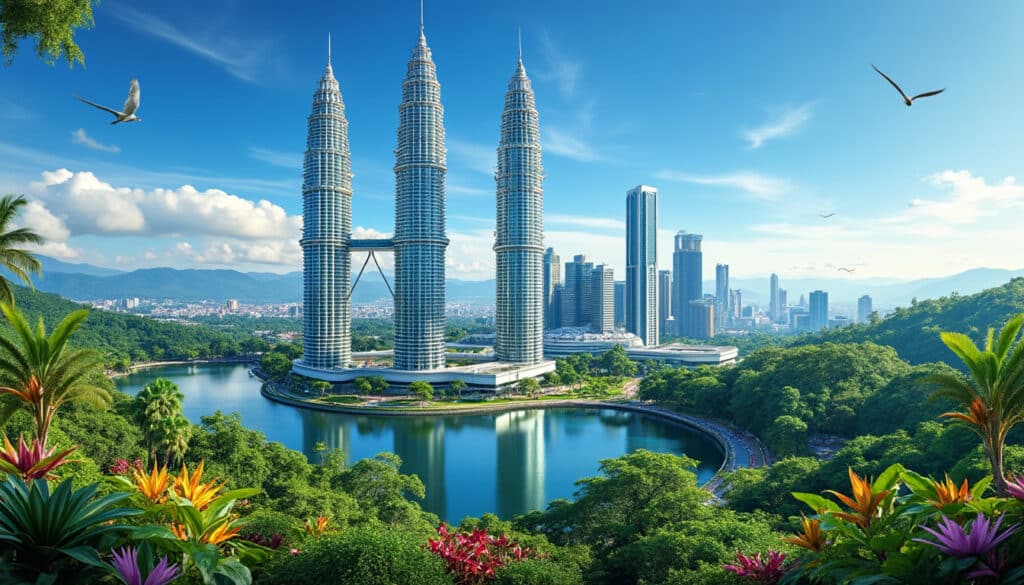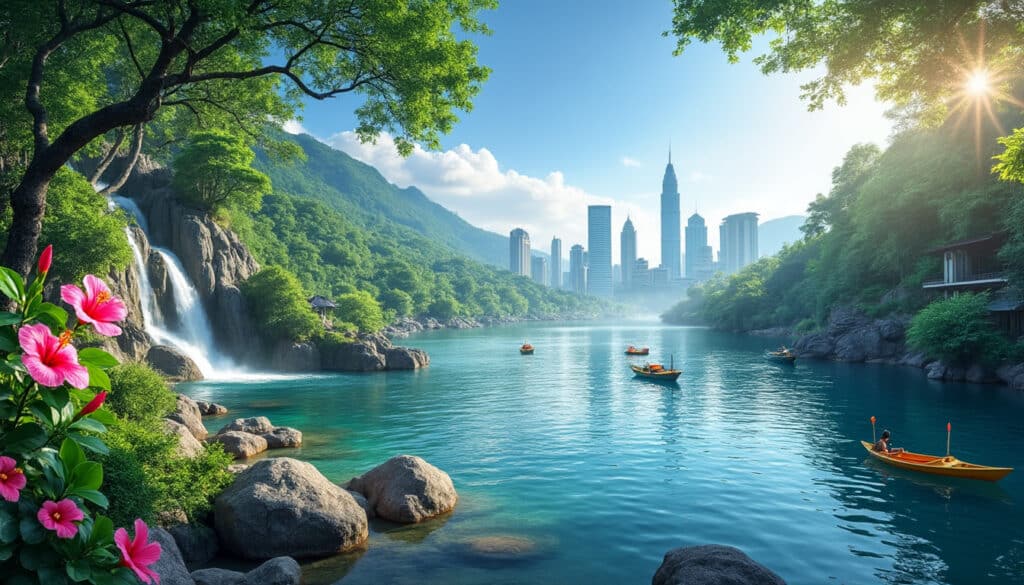Situated in the heart of Southeast Asia, Kuala Lumpur stands as a vibrant metropolis famed for its remarkable fusion of modernity and tradition. This bustling capital of Malaysia is more than just a hub of cultural and commercial activity; it’s a city deeply connected to its geographical surroundings. From its iconic landmarks to its lush green landscapes, Kuala Lumpur offers a unique tapestry woven with natural beauty and urban development. Let’s explore the geographical features that make Kuala Lumpur a destination like no other.
Exploring the Urban and Natural Landscapes of Kuala Lumpur
Kuala Lumpur’s geographical setting is a striking blend of urban sprawl and breathtaking natural landscapes. Nestled in the Klang Valley, the city is surrounded by the Titiwangsa Mountains to the east and the expansive Strait of Malacca to the west. This unique positioning offers both locals and visitors stunning views and an array of outdoor activities. With its highlands, rivers, and lush green parks, Kuala Lumpur truly has it all.
The Kuala Lumpur City Centre (KLCC) is undoubtedly the heart of the city, featuring the iconic Petronas Twin Towers that once held the title of the tallest buildings in the world. These twin towers are a symbol of Malaysia’s economic progress and architectural prowess. Apart from the stunning skyline, KLCC is also home to expansive urban parks and green spaces. For instance, the KLCC Park is a beautifully landscaped area offering a serene retreat from the bustling city life, with water features and walking trails.
For a closer encounter with nature, the Kuala Lumpur Bird Park is a must-visit. Situated within the tranquil Perdana Botanical Gardens, it’s one of the largest covered bird parks in the world. Here, visitors can observe a wide variety of bird species in a lush, open-air environment. The park’s naturalistic setting makes it a favorite among nature lovers and families alike.

The Rivers that Shaped Kuala Lumpur
Kuala Lumpur’s name, which translates to “muddy confluence,” originates from its strategic location at the meeting point of two significant rivers: the Klang River and the Gombak River. This confluence was key in the city’s establishment, facilitating its growth as a trading post during the 19th century. Today, efforts to rehabilitate these rivers aim to enhance their ecological and recreational value, turning them into vibrant riverside attractions.
The Klang and Gombak rivers play a crucial role in the city’s drainage and flood mitigation systems. Innovative projects have turned sections of these rivers into bustling recreational areas, complete with walkways, benches, and landscaping. This transformative approach not only boosts tourism but also aids in boosting the urban ecosystem by supporting diverse flora and fauna.
Notable Natural Reserves and Parks
Kuala Lumpur’s urban sprawl is complemented by its commitment to preserving nature. The Titiwangsa Lake Gardens, also known as Taman Tasik Titiwangsa, is a popular spot for locals and tourists alike. Offering picturesque views of the city’s skyline, it provides a lush escape with its cycling tracks, paddle boats, and picnic spots. The area’s refreshing breeze and serene environment make it perfect for morning jogging or an evening stroll.
More hidden gems lie beyond the urban core. The Forest Research Institute Malaysia (FRIM), located just outside the city, is a verdant oasis covering over 1,500 hectares. It serves as a vital center for scientific research and environmental education while providing visitors with guided canopy walks and nature trails. These facilities demonstrate the city’s dedication to conserving its green heritage for future generations.
Architectural Marvels Within the Geographical Context
The architectural landscape of Kuala Lumpur is deeply intertwined with its geographical context. The city’s architecture is characterized by a harmonious blend of modern skyscrapers, colonial-era buildings, and cultural landmarks, each contributing to its unique skyline. The interplay between the man-made structures and natural elements further accentuates Kuala Lumpur’s allure.
One of the city’s most famed structures is the KL Tower, a prominent telecommunications tower that stands tall against the city’s skyline. Beyond its primary function, the observation deck offers panoramic views of the entire city and its natural surroundings, making it a popular attraction for tourists and photographers.
Another historical landmark is the Sultan Abdul Samad Building, known for its Moorish architecture and striking clock tower. Located in Merdeka Square, this building served as the administrative center during the British colonial era. Its strategic placement and architectural style reflect Kuala Lumpur’s rich history and cultural heritage.
Embedded into the hills just outside the city are the Batu Caves, a series of limestone caves housing Hindu shrines that are a major pilgrimage site for the Thaipusam festival. To reach the temples, visitors can climb 272 steps, with the magnificent statue of Lord Murugan standing guard at the entrance. This sacred site reveals the spiritual dimension of Kuala Lumpur’s geography, offering a profound experience both culturally and scenically.
Integration of Cultural Sites Into the Urban Fabric
The integration of cultural sites into Kuala Lumpur’s urban fabric has enhanced its appeal as a cosmopolitan city with a diverse heritage. The National Mosque, or Masjid Negara, exemplifies this blend of tradition and modern design. With its iconic blue and green dome, the mosque stands as a testament to Malaysia’s Islamic heritage.
Similarly, the Thean Hou Temple is a striking site that exemplifies Chinese cultural influence in Malaysia. Located on a hill, the temple offers breathtaking views of the city below. Its detailed carvings, vibrant colors, and the overall architectural elegance reflect the profound cultural diversity that enriches Kuala Lumpur’s identity.
This fusion of cultural and architectural elements, set against the backdrop of Kuala Lumpur’s geographical features, is what makes the city such an appealing destination. The emphasis on preserving historical sites amidst rapid urbanization is a testament to the city’s recognition of its cultural and environmental heritage.
Climate and Meteorological Influences in Kuala Lumpur
Understanding Kuala Lumpur’s geographical features requires an appreciation of its climate. Located near the equator, Kuala Lumpur experiences an equatorial climate characterized by consistently high temperatures and humidity. The city’s weather is heavily influenced by the monsoon seasons, leading to marked differences in rainfall throughout the year.
The southwest monsoon, from May to September, typically brings less rain, whereas the northeast monsoon, from November to March, results in heavier rainfall and occasional thunderstorms. On average, Kuala Lumpur receives ample rainfall, totaling about 95 inches annually. These climatic patterns impact various aspects of life, from infrastructure planning to daily commuting.
The tropical climate also contributes to the city’s lush greenery and biodiversity, as well as the widespread use of native plants in landscaping. The abundance of rain nourishes the myriad parks and gardens, making them vibrant and healthy ecosystems. The planning of water management systems is pivotal in such a rainy climate, ensuring that the city remains resilient in the face of climate variability.
Flora and Fauna: A Biodiversity Haven
Kuala Lumpur’s rich biodiversity is enhanced by its climate and geographical location. Urban parks and green spaces are home to a variety of flora and fauna, including tropical birds, butterflies, and native plant species. Initiatives aimed at conserving biodiversity have been instrumental in maintaining these natural habitats amidst urban development.
Kuala Lumpur’s gardens, such as the Perdana Botanical Gardens, showcase a variety of plant species from both local and international origins. These verdant areas serve as both recreational spots and vital green lungs, contributing to the city’s air quality and offering residents a chance to connect with nature.
Efforts to increase urban greenery include the planting of trees along major roads, the development of eco-parks, and the creation of green corridors to encourage biodiversity. These initiatives are key to enhancing the quality of life in Kuala Lumpur, providing a sustainable and healthy urban environment.
Connecting and Moving Through Kuala Lumpur
Kuala Lumpur’s extensive transportation network is a testament to its development as a modern metropolis. The city’s infrastructure facilitates seamless connectivity within its diverse neighborhoods and regions, making it accessible to both locals and international visitors.
Kuala Lumpur International Airport (KLIA), located about 50 kilometers south of the city, serves as a major gateway to Malaysia. It connects Kuala Lumpur to destinations worldwide through extensive flight networks. The airport’s facilities and services ensure a comfortable and efficient travel experience for millions of passengers annually.
Within the city, the Kuala Lumpur Monorail and Light Rail Transit (LRT) systems offer efficient public transport options. The monorail links key areas like Bukit Bintang, while the LRT lines connect suburban regions with the city center. These systems help alleviate traffic congestion and reduce commute times, offering a reliable mode of transportation for daily commuters.
| Transport Mode 🚉 | Coverage 🌍 | Key Features ✈️ |
|---|---|---|
| Monorail | Kuala Lumpur City | Connects commercial hubs |
| LRT | Suburban Areas | Extensive coverage |
| KLIA | International | Major global connections |
Overall, Kuala Lumpur’s transportation infrastructure supports its growth as a dynamic and interconnected city. Whether navigating the city for work, leisure, or exploration, these systems ensure that visitors and residents can travel with ease.
Sustainable Initiatives and Future Transport Plans
Kuala Lumpur’s commitment to sustainability extends to its transport systems. Initiatives such as the development of electric buses, bike-sharing programs, and pedestrian-friendly zones aim to reduce the city’s carbon footprint and enhance its public transport network. Urban planners are continuously exploring innovative strategies to expand and improve transport infrastructure, ensuring it meets the needs of a growing urban populace.
Efforts to input technology-driven solutions, like smart traffic systems and data analytics, are focused on optimizing traffic flow and reducing congestion. These forward-thinking approaches ensure that Kuala Lumpur remains a model of urban mobility, blending contemporary practices with geographical insight to create an efficient and livable city.
Frequently Asked Questions about Kuala Lumpur’s Geographical Features
What is the significance of the Klang and Gombak Rivers?
The Klang and Gombak Rivers form the confluence known as “muddy estuary,” which played an integral role in Kuala Lumpur’s early trade and development. These rivers continue to shape the urban landscape, offering recreational spaces and supporting biodiversity.
How does Kuala Lumpur’s equatorial climate influence its geography?
The city’s equatorial climate leads to year-round tropical weather, abundant rainfall, and lush greenery, contributing to its varied natural landscapes and rich biodiversity.
Which transportation options are available in Kuala Lumpur?
Kuala Lumpur offers several transportation options, including the Monorail, LRT, and KLIA for international travel. These systems provide extensive coverage and are integral to navigating the city efficiently.
Are there significant cultural landmarks in Kuala Lumpur?
Yes, Kuala Lumpur is home to numerous cultural landmarks such as the Petronas Twin Towers, Batu Caves, National Mosque, and Thean Hou Temple, each capturing the city’s cultural diversity and historical significance.
What sustainable initiatives have been implemented in Kuala Lumpur?
Kuala Lumpur is actively implementing sustainable initiatives, including electric buses, bike-sharing programs, and smart traffic systems as part of its commitment to sustainability and reducing carbon emissions.

Nature and Geography of Kuala Lumpur
Kuala Lumpur, the vibrant heart of Malaysia, is a city where urban landscapes seamlessly blend with nature’s remarkable bounty. Renowned for its eclectic mix of modernity and natural wonders, this city is an epitome of Asian metropolitan charm. As an…

Location and coordinates of Kuala Lumpur
Kuala Lumpur, the dazzling capital of Malaysia, stands not only as a bustling hub of culture and commerce but also as a focal point of geographical interest. Nestled strategically in Southeast Asia, this vibrant city exudes a unique mix of…

Nature and wildlife in Kuala Lumpur
While Kuala Lumpur is renowned for its towering skyscrapers and bustling city life, it also offers a verdant escape into nature and wildlife. Amidst the vibrant urban pulse, the city is surrounded by lush greenery, teeming wildlife, and serene parks,…

Rivers and water near Kuala Lumpur
Flowing through the heart of Malaysia, the rivers near Kuala Lumpur form an intricate tapestry of nature, history, and recreation. The bustling cityscape hides these natural treasures, offering serene getaways for those who seek a splash of tranquility. Whether you’re…

